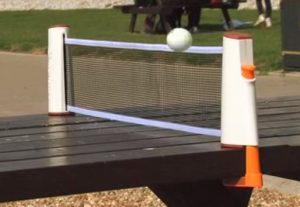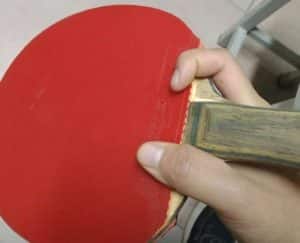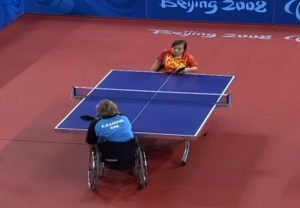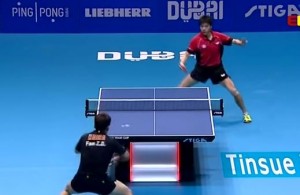There is one type of ping pong ball which is specially designed for blind people to play table tennis. The ball has lead particles inside the ball, which can make a pleasant sound when it is rolling.
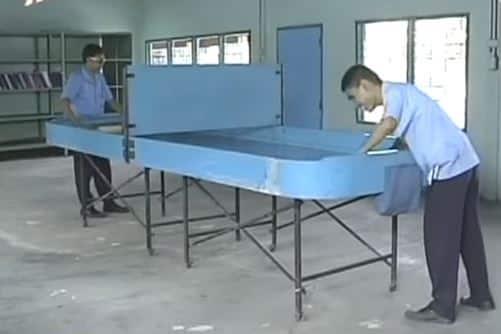
The table tennis table’s size and dimensions are the same as that of a standard table tennis table, except that a bezel surrounded by wooden slats is added around the table.
During the game, the ball is judged according to the sound of the ball rolling. The players should push the ball hit by the opponent back from the net before hitting the bezel in his defensive zone.
A player will lose the point if he missed the hit, or hits the ball out of the board,and hit the ball too high and get contact with the net.
Each game is played for 11 points and three games. The rules are based on the Sound Table Tennis Rule, which was implemented in 2002.
Table of Contents
Popular Sports For People With Visually Impaired
Blind table tennis is one of the most popular sports for people who are visually impaired. This sport does not require too much space. As long as it can accommodate a standard table tennis table, two people can enjoy playing it happily.
Even for those who are just having the first contact with the sport, they can still master the essentials skill to play the game in a short period.
The general situation of blind table tennis matches
Blind table tennis is different from ordinary table tennis. Blind table tennis uses a racket to hit a particular table tennis ball that can make a sound and roll on the table.
When the ball hit by the opponent enters the receiving area, and before it touches the table frame, the player needs to hit back the ball. If the opponent’s ball touches his or her table frame or flies out of the table, then the player will lose a point in the game.
The preparation before the game and the structure of the table
- During the competition, a blindfold is worn regardless of blindness or amblyopia.
- Draw lots or other methods are used before the game starts for players to confirm the service or choose the side. After a player serves five times, the right to serve is exchanged to the other player.
- In the official competition, 21 points or 11 points per game are adopted, and it is played in the best of 3 games.
Structure of Table Tennis Table
- The tabletop’s color is white or dark green, and the standard tabletop is usually made of a whole piece of wood without joints.
- The side frame and the two ends of the table are built with a side frame (60 cm) and a bottom frame (about 150 cm). The side frame and the bottom frame have a height of 1 cm.
- The line connecting the center point of the bottom frame of the two ends of the table is called the centerline, and the table is divided into two parts.
- The line at the top of the side frame is called the serve line, and the receiving area during the game is located at the receiving line, the bottom border, and the side, within the range between the borders.
- The net should be 4cm to 5cm above the table. The table’s length, width, and height are the same as those of a standard table tennis table.
Rules of Playing and Scoring
Preparatory actions:
Players need to bend down to the tabletop, do not stay away from the tabletop. Tilt the racket slightly forward and close to the bottom frame at any time. Do not leave the tabletop when moving left or right.
Serve rules
- A player should serve the ball from the right side of the table to the other side. The ball needs to go to the left side of the opposite table.
- Before serving, a player needs to inform the opponent that he/she is “ready to serve the ball”. After the opponent answers “Okay,” only then can the player make the serve.
- When doing the serve, if the ball hits the net, it is counted as a mistake of the player. Therefore, the player is going to lose a point.
- Before the serve, the racket is prohibited from touching the ball. Double-hit on the serve will result in a penalty.
Receiving Rules
- When receiving the serve, a player needs to carefully confirm the center line to see if it serves to the table’s right side. If the ball goes to the centerline’s left side, the opponent can choose not to receive the ball.
- To ensure the player’s strength to receive the ball and the accuracy of the direction when hitting the ball, a player should move as fast as possible according to the direction indicated by the sound of the ball.
- A player should move his/her hand between the bottom frame and the side frames. When the ball is in front, the player can get close to it and hit the ball.
- A player needs to pay attention to control the strength of the ball. When receiving a ball with great force from the opponent, try to hit the ball vertically to avoid the slanting ball. Otherwise, it can cause the ball to fly out of the table and lose points.
- Even the ball that is being rolled by the opponent does not reach the receiving line yet. You can still receive the ball.
How to Score?
Self Scoring:
- The ball hits the bottom of the opponent table and falls on the tabletop.
- The ball hitting out by a player is not received by the opponent. The ball hit the bottom border or side frame of the other side twice before flying out of the table.
- The ball hit out by the player stops before the opponent catches the ball in the receiving area of the opponent table.
- The opponent does not hit the ball back, or the ball flies out of the table when the opponent tries to return the ball.
Opponent Scoring:
-
Serve mistakes:
- Hit the ball twice when serving.
- The racket touches the ball before serving.
- The ball hits the net when serving.
- The ball flies out of the table when hitting.
- The ball hitting out is not returned by the opponent. The ball then hit the bottom border or side frame of the other side and flew out of the table.
- After hitting the ball, it hits the net and stops or flies out of the table.
- The ball hitting the other side did not cross the opponent’s receiving line.
- Touching the ball above the wrist will result in a foul.
- The non-swing action is defined as the arm holding and the body remains relatively stationary.
- In addition, any arm movement is judged as a swing and is determined as an action for receiving the ball.

Warren Davies

